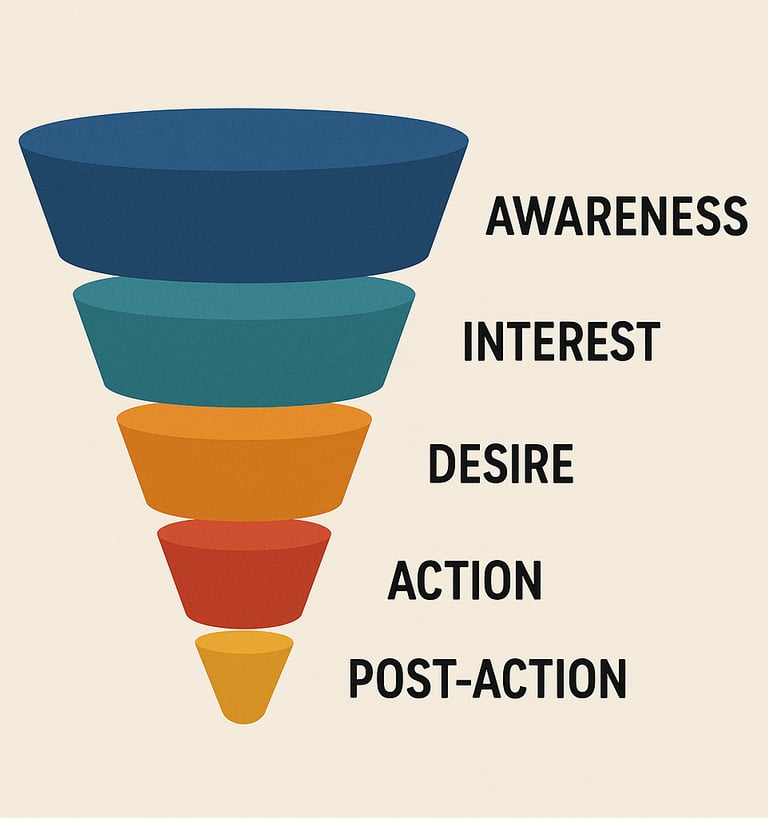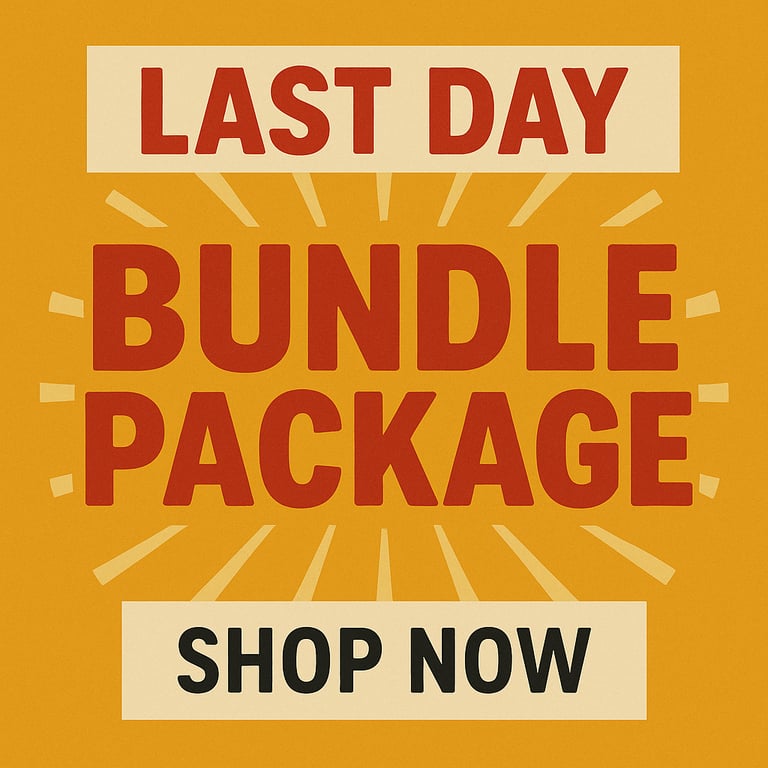Sales Funnels Part 1: The Psychology of Sales Funnels
All about sales funnels in our 3 part series of blog insights!
Alexie
5/25/20256 min read

We've all heard about it - Sales Funnel. The gurus on social media screams, "You need a funnel. A landing page. Automated bot responses, Post on social media. Do webinars. Offer newsletters." Your friends are telling you, "You need to do content. Get influencers. Advertise on social media."
All because you wanted to drive more sales to your business, the barrage of unsolicited but well meaning advices rain in. Most of these advice providers probably haven't sold a single product or run a business before but they've all watched a bunch of Facebook videos on it. Facebook videos on the "Secret System of Selling" - only if you pay for their courses. That ONE technique. That gatekept da vinci code to riches. And all you want to do is increase your sales in a systematic way.
So much noise; The internet gurus are screaming down your ear, permeating even your most sacred spaces - your DMs. Let me tell you something - they are ALL referring to: a sales funnel system and its micro details.
So what is it and how can you make sense/use of this?
A bit of history... (You can skip this part but this is me geeking out)
Traditionally (we're talking MNCs), Marketing and Sales are in 2 separate departments. In these segmented scenarios, there is often a contentious dynamic between these departments. Understandably why; They're both in the same process of acquiring customer sales (bottom line) which comes from marketing (top) but then why are they in separate departments? Well, traditionally companies believe that these are separate skillsets i.e. marketing is mass, sales is direct.
The biggest weakness in this system is siloed off arms to the same end goal. What often happens when performance review time is - marketing blames sales for not being able to convert and sales blames marketing for its poor numbers (bad messaging = bad first impressions).
Our ever competitive and revolving world demands this to end. Thus a more unified Revenue/Operations department is born. Individuals trained and skilled in different facets of the buyer journey. And then, a sales funnel is born.
The beautiful matrimony of Marketing & Sales (or B.D. for B2B).
What happens when 2 used to be separate departments merge? You have a single unified system that fully encapsulates the customer/buyer journey and looks at key points to sway them towards the brand/company. Plus now, there's also the operational aspect (what happens post-purchase).
A sales funnel has 1 end goal - sell and sell more.
How you get there is an amalgamation of Marketing (part 1) + Sales (part 2) + Ops (part 3).
How to put it to practice:
A sales funnel is the psychological journey of a buyer from awareness to decision. Every step aligns with emotional triggers and decision-making biases.
The journey goes from:
Stage 1 - Awareness
Stage 2 - Interest
Stage 3 - Desire
Stage 4 - Action
Stage 5 - Post-Action
Sales is just like dating. To get in a relationship, you need to have the awareness of the existence of such a person, Then you take interest in said person - they're cute! Then you as you further understand/get to know the person, you realize that you have a desire i.e. oh they're funny, cook well, confident, kind, etc. That's when you take action ;) - ask them out! After multiple actions, you have the relationship (post-action).
Selling products/services is the same exact thing!


Date your clients. Figuratively.
In this 3 part series, we will start with a depth of understanding of the psychology of your customers/clients' journey
1. Awareness - Capture attention
To know is to love
Your first contact with customers is the awareness stage - the first impression. Whether its a campaign with integrated brand messaging or your sales person cold called someone or your B.D. has approached a new potential client at a networking event. People get a feel for your brand and the key triggers that we hope to derive from are: Curiosity, novelty bias, and/or problem awareness.
E.g. you're a B2B accounting SaaS and you'd like to reach a new market. You may try to trigger problem awareness through either clients who have never used any accounting software, clients who are using a traditional accounting software, or clients who are using a competitor's accounting SaaS (How do you identify these are your main targets are through your own understanding of your target market). The team has identified that clients who are using a competitor's accounting SaaS (particularly a specific brand) are the EASIEST to convert as the competitor's product is not user friendly and more expensive. You run a campaign that communicates - hey we're easy to use and we're affordable! Making it accessible to even mom & pop shops.
Boom! Now your clients are aware of the problem. As a client, I now have the awareness that taking 3 hours do filing on my accounting SaaS is a problem and that it should take only 30 minutes.
2.Interest - Build connection, establish credibility
Now you've got their attention; Time to dance through storytelling, empathy, trust-building.
From that campaign you've just run, clients are booking for a demo session. You take them through the product benefits and talk about how it has helped others in similar situation. This is where the human touch begins with building a story, empathizing with your client, and most importantly - ensure you build trust and that your product truly solves the customers' problems.
In the B2B accounting SaaS, the company will take case study of similar clientele (in similar business structure & industry); And then demonstrate how it is used on a daily basis and on its integrations with their other systems. Highlight also that generally the product is cheaper to use.
3. Desire - Position Product as "Must-Have"
Dangle the carrot - Scarcity, social proof, value stacking.
Create a strong desire to try it out. Customers at this point are sold on your benefits, they know you're good but they're just suffering from "decision inertia". The decision inertia is when someone needs to do something but hasn't quite done it because of their risk-adverse comfort ways - its psychological. So how do you break this?
Through creation of scarcity promotions + social proof (your friends/competitors are using it type of case study/testimonials) + value stacking (sign up now to get a bundle). These creates a strong desire to act within a set period of time. It's the same reason events offer early bird ticket promos. It's the same reason companies looking to GTM in a new locale offer HEAVY promotional items.
It's all done to combat the "I like it but I don't know if I'd like to try it out" "It seems better but is it really?" "Should I try to use this?" "I like it but I mean its working fine now I don't know maybe I'll make a decision later". These are all decision inertias that cripple decision making causing customers to go from NOW to MAYBE LATER.
This creates a precursor to ACTIONS.


4. Action - Trigger Decision & Commitment
After you've done all of the above, you need to break the decision inertia and remind them on what they're missing out on.
Chances are - customers/clients are not in a hurry to spend on your product. It's something that they look at and are interested but are not looking to switch or start. You need to break this comfort zone through triggering urgency. This is when you need to trigger their Fear of Missing Out.
This is essentially making the buying barriers super low. Make purchases super easy (through lesser clicks/just say yes) and urge them to close out this deal.
This part should be the easiest and most common psychological trick in the sales book. We're not going to talk too much to bulk this up but the next step is the most crucial!
5. Post-Action - Build loyalty, reduce churn, upsell
What do you do now that you've sold? Well, first off - don't make them regret their decision! Customers at this point they're likely still doubting your product/service. They're going to try it out and they try and judge if they've made the right decision.
Well, this is a product (or services if service-based business) aspect but beyond that - how do you safeguard your business? What is going on with each customer?
Chances are - your competitors are doing their product changes and improvements + they're also looking to bankroll a superb promotional campaign. Suddenly your clientele is gone. What the... All that work down the drain?
This is when you'd need to build a voice or platform within your clientele/customer community. The psychology of it is you need to give your customers an identity with your brand alongside it and a space of belonging. Depending on whether you're B2B, B2C or DTC, the way you do this may be very different but common methods include events and a social channel. Listen to what they say. Reward loyalty. Be generous! And you'd be rewarded with clients who will literally tell their friends to switch the moment they can bring it up in a conversation.
Looking to build your sales funnel?




Speak with an expert member of the team. Forget guesswork and trying to do everything yourself. Get help from people who have done it successfully.
Find us
Vida Bukit Ceylon, Kuala Lumpur
hello@aressa.co

2025 Aressa Collaborative Sdn. Bhd. All rights reserved.
